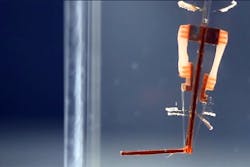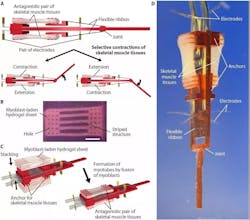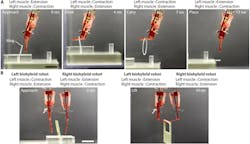Soon, Robots Will Be Flexing Real Muscles
Robots have been receiving several upgrades in recent years in light of technological manufacturing innovations. 3D printing has given several robots a lighter footprint, advances in motors and pneumatics have made them more powerful, and artificial intelligence has made them smarter. The next stage comes from a research group at the University of Tokyo that involves giving robots actual living muscles for movement. This new field of biohybrid robotics looks to replace the metal and plastic motion components, with functional living tissue.
The biohybrid space is a new field of study looking to create living tissues for robots. (Image credit: Institute of Industrial Science, University of Tokyo)
Constructing Muscles for Robots
The study from the University of Tokyo Institute of Industrial Science was published in the journal Science Robotics last month. The paper describes a new method developed by the team that progresses from individual muscle precursor cells to muscle cell-filled sheets and then to complete functioning skeletal muscle tissues. These muscles were incorporated into a biohybrid robot as antagonistic pairs, such as a bicep and tricep, mimicking those in the body to create human-like movement.
The first step was to create a robot skeleton for housing the pair of muscles. The muscle assembly included a rotatable joint, anchors for the muscles, and electrodes to provide stimulus for muscle contraction. The muscles themselves are formed from a hydrogel sheet containing muscle precursor cells called myoblasts. The muscles have holes in them to attach them to the anchors and stripes to encourage muscle fibers to form.
The image above demonstrates how the hydrogel muscle is stimulated to extend and contract, like a bicep and tricep working in unison. (Image credit: Institute of Industrial Science, University of Tokyo)
“Once we had built the muscles, we successfully used them as antagonistic pairs in the robot, with one contracting and the other expanding, just like in the body,” study corresponding author Shoji Takeuchi says. “The fact that they were exerting opposing forces on each other stopped them shrinking and deteriorating, like in previous studies.”
The muscles were tested in different applications to test their range. The team tested the robot by having it pick up and place a ring, and also had two robots work in unison to pick up a square frame. The initial tests proved that the muscles were strong and flexible enough to perform these tasks well.
See the video below to see the muscles in motion.
“Our findings show that using this antagonistic arrangement of muscles, these robots can mimic the actions of a human finger,” lead author Yuya Morimoto says. “If we can combine more of these muscles into a single device, we should be able to reproduce the complex muscular interplay that allows hands, arms, and other parts of the body to function.”
Can Robot Muscles Work for Humans?
The research team from the University of Tokyo conducted tests to demonstrate the range of motion of the muscle. The tests included placing a ring and two muscles working together to lift an object. (Image credit: Institute of Industrial Science, University of Tokyo)
The future of this research has great potential not just for robotic applications, but also for humans. These biohybrid robot muscles could replace missing muscles and appendages on humans. The University of Tokyo team suggests that its research is laying the groundwork for such a possibility, but it is focusing on more life-like robotics first.
The current setup requires refinement. The electric current induced through the muscle is done in water. When the current is applied, it creates bubbles in the surrounding water. This is a major contributing factor in the degradation of the tissue. The team is investigating other methods to stimulate the movement without using electricity. Some may use a motor neuron to control the stimulation of the muscles.
Research has been done that proves that a small neural device can be grown capable of remotely controlling muscles. An entire network can be grown from motor neuron cells and controlled by using lasers to stimulate the neurons. The overall control of these muscles, the amount of force they can exert, and the amount of time before they start to shrink and lose their function, are problems that the team is looking to solve as the research progresses.




